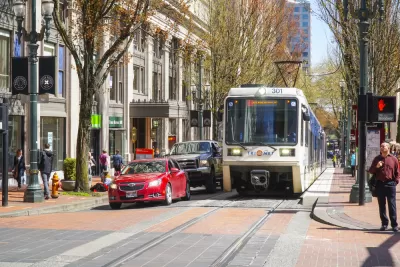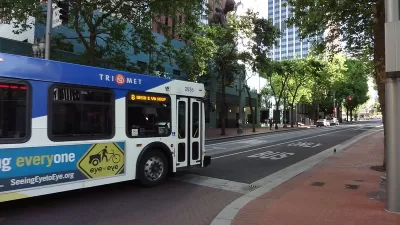Oregon Metro and TriMet are studying the feasibility of a subway tunnel under Portland that would cross under the Willamette River to speed up MAX trains through the city.

Andrew Theen reports that Metro, the regional government for the Oregon portion of the Portland metropolitan are, and Tri-County Metropolitan Transportation District of Oregon (TriMet) will study an ambitious tunneling project that would "build a tunnel underneath downtown Portland and the Willamette River to speed up light rail trains and provide an alternative river crossing to the aging Steel Bridge."
"The regional government quietly posted a new website this week dedicated to the MAX tunnel project, which would put MAX trains underground from roughly the Lloyd Center to Goose Hollow in Southwest Portland," according to Theen.
Metro officials are stressing the speculative nature of the feasibility study, likening it to "planning for a plan." The website is asking for comments on the tunnel project, however.
Theen is able to share a few speculative details for the project, too: "The overall tunnel project would likely cost at least $1 billion. A preliminary concept described a “twin-bore east-west transit tunnel” that would emerge on the west side on Jefferson Street near SW 16th and on the eastside near NE Holiday Street at 16th Drive."
Given the preliminary nature of the project, Theen is able to reveal a lot more context for the project, and its potential impact on the city.
FULL STORY: Metro will study MAX tunnel underneath downtown Portland and Willamette River

Study: Maui’s Plan to Convert Vacation Rentals to Long-Term Housing Could Cause Nearly $1 Billion Economic Loss
The plan would reduce visitor accommodation by 25,% resulting in 1,900 jobs lost.

North Texas Transit Leaders Tout Benefits of TOD for Growing Region
At a summit focused on transit-oriented development, policymakers discussed how North Texas’ expanded light rail system can serve as a tool for economic growth.

Why Should We Subsidize Public Transportation?
Many public transit agencies face financial stress due to rising costs, declining fare revenue, and declining subsidies. Transit advocates must provide a strong business case for increasing public transit funding.

How to Make US Trains Faster
Changes to boarding platforms and a switch to electric trains could improve U.S. passenger rail service without the added cost of high-speed rail.

Columbia’s Revitalized ‘Loop’ Is a Hub for Local Entrepreneurs
A focus on small businesses is helping a commercial corridor in Columbia, Missouri thrive.

Invasive Insect Threatens Minnesota’s Ash Forests
The Emerald Ash Borer is a rapidly spreading invasive pest threatening Minnesota’s ash trees, and homeowners are encouraged to plant diverse replacement species, avoid moving ash firewood, and monitor for signs of infestation.
Urban Design for Planners 1: Software Tools
This six-course series explores essential urban design concepts using open source software and equips planners with the tools they need to participate fully in the urban design process.
Planning for Universal Design
Learn the tools for implementing Universal Design in planning regulations.
Ascent Environmental
Borough of Carlisle
Institute for Housing and Urban Development Studies (IHS)
City of Grandview
Harvard GSD Executive Education
Toledo-Lucas County Plan Commissions
Salt Lake City
NYU Wagner Graduate School of Public Service





























